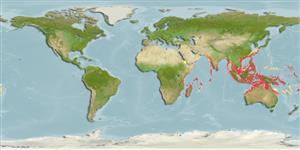>
Eupercaria/misc (Various families in series Eupercaria) >
Lethrinidae (Emperors or scavengers) > Monotaxinae
Etymology: Gymnocranius: Greek, gymnos = naked + Greek, kranion = skull (Ref. 45335).
Environment: milieu / climate zone / depth range / distribution range
Écologie
marin démersal; non migrateur; profondeur 50 - 100 m (Ref. 2295). Tropical; 35°N - 25°S
Indo-West Pacific: east Africa and Seychelles to the Solomon Islands, north to southern Japan, south to northern Australia.
Taille / Poids / Âge
Maturity: Lm ? range ? - ? cm
Max length : 35.0 cm TL mâle / non sexé; (Ref. 2295); common length : 25.0 cm TL mâle / non sexé; (Ref. 2295)
Épines dorsales (Total) : 10; Rayons mous dorsaux (Total) : 10; Épines anales: 3; Rayons mous anaux: 10.
Inhabits sandy or low-relief rocky bottoms (Ref. 11228). Feeds on bottom-living invertebrates. Marketed fresh (Ref. 9775). May be solitary or in small groups, on flat offshore trawling grounds, occasionally near shallow coral reefs (Ref. 90102).
Life cycle and mating behavior
Maturities | Reproduction | Spawnings | Egg(s) | Fecundities | Larves
Carpenter, K.E. and G.R. Allen, 1989. FAO Species Catalogue. Vol. 9. Emperor fishes and large-eye breams of the world (family Lethrinidae). An annotated and illustrated catalogue of lethrinid species known to date. FAO Fish. Synop. 125(9):118 p. Rome: FAO. (Ref. 2295)
Statut dans la liste rouge de l'IUCN (Ref. 130435)
Menace pour l'homme
Harmless
Utilisations par l'homme
Pêcheries: intérêt commercial mineur
Outils
Articles particuliers
Télécharger en XML
Sources Internet
Estimates based on models
Preferred temperature (Ref.
123201): 23.2 - 28.2, mean 26.7 °C (based on 312 cells).
Phylogenetic diversity index (Ref.
82804): PD
50 = 0.5010 [Uniqueness, from 0.5 = low to 2.0 = high].
Bayesian length-weight: a=0.01778 (0.00761 - 0.04154), b=2.97 (2.78 - 3.16), in cm total length, based on LWR estimates for this (Sub)family-body shape (Ref.
93245).
Niveau trophique (Ref.
69278): 3.4 ±0.41 se; based on food items.
Résilience (Ref.
120179): Milieu, temps minimum de doublement de population : 1,4 à 4,4 années (Preliminary K or Fecundity.).
Fishing Vulnerability (Ref.
59153): Low vulnerability (25 of 100).
